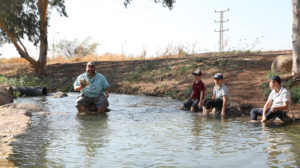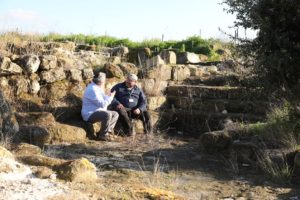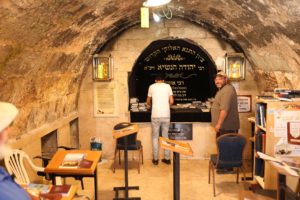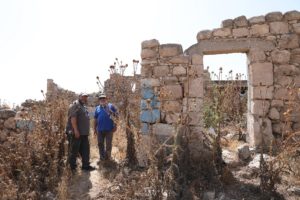The Trek to Tel Dan
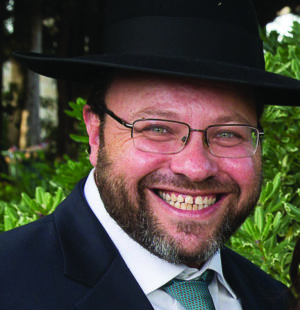
Stuck inside? Pesach trip canceled? Join Rabbi Ephraim Schwartz for a virtual tour instead
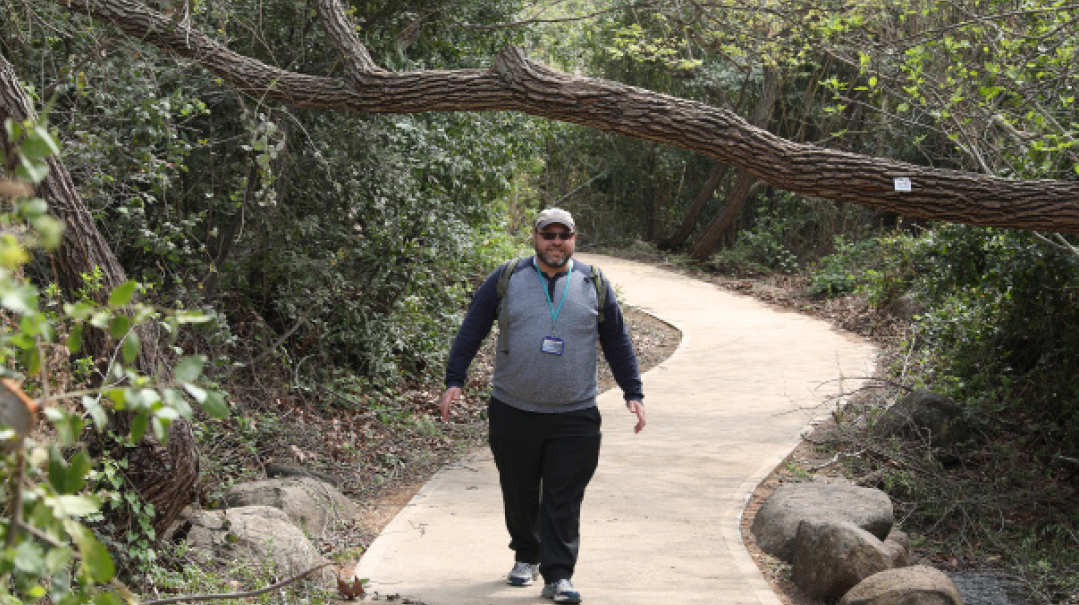
Photos: Menachem Kalish
If you’re stuck inside dreaming of blue skies, rushing water, and the joy of watching your kids run freely through the grass, you’re in good company. You’re also in the right place, because we’re about to take a virtual tour of what is in my humble opinion one of the most amazing sites in Eretz Yisrael — Tel Dan. Usually I do my tours in person, but we’re all discovering new talents and abilities these days.
A River Runs through It
Our tour begins with an incredible overlook of the Dan River. This year our tefillos of v’sein tal u’matar have been answered in abundance. Whereas last year the river was a mere trickle in many places, today the river is roaring.
The Dan River is one of the three major rivers that flow down from the Chermon, Israel’s highest mountain, which is on the border of the Golan Heights and Syria; the other two are Nachal Senir (Hatzbani) and Nachal Chermon (Banias). All three rivers converge and become the Yarden (aka the Jordan River). The Dan is the largest of the three — in fact, it’s bigger than the other two put together — and provides more than half of the water in the Yarden.
By the way, “Yarden” comes from the words yored Dan — the downflow of the Dan River. The Yarden flows down to the Kinneret, which flows down to the lower Yarden and to the Dead Sea. After four years of drought they were both drying up. The gishmei brachah of the past two years have them brimming with water.
Wade a Minute
Following the trail, we come upon a big wading pool. Usually this pool is full of children frolicking in the waters. Everyone loves the water here in Eretz Yisrael, and so this is one place where you can see Jews of all kinds — chareidim from Yerushalayim and chilonim from Tel Aviv — as well as Arabs, all of them enjoying a fun afternoon together. There are no politics or religious differences — and because it’s just a wading pool with little kids splashing around, tzniyus is usually not a problem. Today, however, when everyone is under quarantine, it’s eerily quiet.
Shoftim Stop
The majority of Sefer Shoftim describes the stories and wars of the shevatim and their leaders after they conquered the Land. The shofet with the most “face time” is Shimshon of shevet Dan, who gets four perakim. He’s certainly the most difficult shofet to comprehend. This one-man fighting machine against the Plishtim didn’t command an army. And he is handed over by the people to the Plishtim, where, after his downfall with his Plishti wife Delila, he meets his end. But this difficult navi opens the door to a subsequent chapter in the sefer, which is the story of how Shevet Dan moved to the next stop on our itinerary.
Oy, Dan
If walls could speak, as the saying goes, the almost-3,000-year-old walls of the city of Dan would have a lot to say. We can approximate the age of the walls because of their two types of construction. First, there are the big boulder-sized original rocks that make up the bulk of the wall. There are also a few places on the upper part of the wall which have Roman-style shaved bricks similar to Herodian stone. This tells us that Dan’s city was inhabited from the early period of the Shoftim all the way through Bayis Sheini.
Inside the gate of the city is a podium, where there was once a throne. From Tanach we know that the gate of the city was where the shofet sat, and it’s amazing to see Tanach come alive before your eyes. Imagine the dinei Torah that might have taken place here!
In other words, this is a perfect spot to open up a Tanach and read a story — one of this tour guide’s favorite things to do. We begin with the chapter in Navi that describes how the tribe of Dan didn’t successfully conquer their portion, which is the central coastline of Eretz Yisrael — from above Ashkelon to north of today’s Bnei Brak and inland to near Beit Shemesh. Today the Gush Dan region is the most populous of Israel, with almost half of the country living there. Back then, though, the terrorism of the Plishtim was too much to bear. The tribe of Dan therefore needed somewhere else to live.
Spies were sent to scout out possibilities. Along the way the spies stopped off in Har Ephraim, at the home of Micha. Chazal tell us that Micha was the adopted son of Moshe (Moshe had pulled him out of the bricks back in Egypt). Micha had an idol that he had taken out of Mitzrayim. He also had the grandson of Moshe living with him, Yehonasan, who was his Kohein. The spies received Yehonasan’s blessing to come to this beautiful city, which was then called Layish.
Lush Layish seemed to have everything they needed. There was plenty of water and its isolation made it vulnerable to an attack. The spies reported all this to their tribe, and 600 armed men came up to Layish. After they took Micha’s idol and Yehonasan to be their Kohein, they conquered and burned down the city.
The burnt rocks that the city was rebuilt with can still be seen—an awe-inspiring sight, as the words of the Navi are revealed before our eyes. The story concludes that as long as the Mishkan was in Shilo, this was a place of alternate worship by Shevet Dan. Oy, these Dannites.
No Bows, Please
Right outside the gate is a small altar made of rocks. This may be a bamah that they used for worship. Archeologists who excavated here in the early 1990s found shaved rocks near them. Perhaps they are the even maskit that the Torah tells us were a form of avodah zarah — people would prostrate themselves on them. I’ve had tourists who wanted to fulfill the mitzvah to break them. I didn’t recommend it. Although I certainly told them they shouldn’t bow down there or bend down to tie their shoes either.
One of the more amazing finds in Israel was found near this small bamah: a rock dating from the end of Bayis Rishon with a large inscription in Aramaic that mentions malchus beis Dovid. Archeologists think the inscription was likely about the victory of King Chazael of Aram over the Northern Kingdom of Yisrael in the ninth century BCE. This is the oldest find that mentions Dovid Hamelech, and it debunked many of the theories of the early “bible critic” school of archeologists, which claimed that Dovid’s kingdom wasn’t that large.
Avraham Avinu Was Here?
Walk another five minutes or so and you’re transported 800 years earlier, to the period of the Canaanim. This huge mud-brick gate and wall was discovered underneath the Israelite city walls of Dan. We knew that the Canaanim used mud bricks for construction, but who knew they knew how to make archways? Once again, a find in Eretz Yisrael shook up the archeological world; until this discovery in 1979, it was assumed that the technology of making archways wasn’t developed until much later in history — perhaps as late as the Greeks. But this wall and its gate were built with three archways holding it up. To date, these are the oldest archways in the world and they were discovered right here.
But that’s not the only reason why this gate is of interest. A sign states that the gate is called the Gate of Avraham Avinu. What does Avraham have to do with this part of the country? Didn’t he live far away, in Chevron and Be’er Sheva? Even if the gate is from his time period, why call it after him? Once again, we turn to our Tanach for the answer, this time to Sefer Bereshis (so even yeshivah guys who don’t know Nach should know this).
In Lech Lecha, we read about the Torah’s “World War I,” when the four kings led by Amrafel/Nimrod fought against the five kings. In that battle, which it seems took place near the Dead Sea and Sodom, Lot is captured. Chazal tell us that Og tells Avraham that Lot has been taken, and Avraham marshals an army of 318 men to rescue him. This Chazal is a bit puzzling, because Og is the King of the Bashan, which is the area known today as the Golan Heights. How does Og know about a battle that took place so far away?
The answer is in the next pasuk, which tells us that Avraham chased the kings until — guess where? You got it: Dan. It seems that Og was probably the only one who knew that Lot was taken here, because he lived right across the street.
But there is still a puzzling question about this incident. The city of Dan is named after Avraham’s great-grandson, yet the Torah is calling it Dan during Avraham Avinu’s lifetime. Perhaps the reason is to tell future generations that when we come here later and excavate the city of Dan, we should dig a little deeper. If we do, we will find the city and gate where Avraham rescued Lot. Does it get any better than that?
Golan Fights
Further along the trail is an overlook of the Golan. It’s a great place to pull out a map and appreciate what Israel looked like before the 1967 Six Day War. Kibbutz Dan, next to Tel Dan, was on the border; to the northeast was Syria and to the northwest was Lebanon. For years the Syrians tried to divert the headwaters of the Yarden into Syria and away from Israel. The contractor hired to do the job was none other than Mohammed Bin Laden — the father of Osama.
Eli Cohen, Israel’s spy in Damascus, got schmoozy with him and was able to pass on information to the Israelis about how to blow up the works. The nefarious plot was foiled, and today the remains of one of those Syrian tractors is still there. Tragically, Eli Cohen was caught not long afterward and hanged publicly in Damascus. Until today, we don’t have his body to bring to kever Yisrael.
On the last day of the war, the Israelis liberated the Golan Heights and returned the area of half of Shevet Menashe, the half on the other side of the Yarden, to Israel.
Mikdash of Yeravam
I always like to tell my tourists that if I can’t take them to Yerushalayim and show them the Beis Hamikdash — yet — I can at least show them something close: a mikdash and mizbeiach which were built by someone who actually saw the Beis Hamikdash and built his own at the spot where our tour ends.
“Wow” is the usual awed response I get, when we turn a corner and look down upon a huge complex that has a large staircase and mizbeiach, which is approximated to be the same measurements of the one that was in the Beis Hamikdash. There is a smaller side-room complex where archeologists have found the spoons and shovels for the making of the ketores (incense). Another room has a metal frame that is built to look like a four-horned mizbeiach. Archeologists found steps there that must have led up to this altar, making it the kodesh perhaps.
Who built this structure? To find out, we have to move from Sefer Shoftim to Melachim and the story of Yeravam Ben Nevat. After the death of Shlomo Hamelech, his son Rechavam takes over. He has a hard job, because his father was the smartest person in the world. (I tell my kids that they will have the same challenge one day.) He decides to disregard the words of the elders who tell him to lower taxes and listens to his young chevreh, who tells him to raise them. Yeravam, who was one of the great leaders at the time, sees the situation isn’t good and decides to break away and start his own shtibel up north, at this spot, and another in Beit El.
This mikdash, which he built, became the central place of worship for the Ten Tribes, until they were exiled by Sancheirev. Yeravam also erected huge security fences and no one was permitted to go to Yerushalyim to be oleh regel. Not a good thing.
Some of my more observant tourists note that the mizbeiach has steps and is made out of shaved stones, both of which a mizbeiach can’t possess, according to halachah. But when you look carefully, you can see that the shaved stones and steps are really a later Bayis-Sheni-era construction. Perhaps they were made by the Greeks and Romans who used this place for their pagan worship. Underneath those later steps are the uncut stones of the original mizbeiach, which were laid down on a slant and might be the original ramp.
May we see a mizbeiach of this size in Yerushalayim soon!
A Taste of Gan Eden
The Israeli Parks Authority named our route the “Gan Eden” trail, thanks to its beautiful flora, streams, and springs. That’s why I like to share with my tourists the Medrash where Hashem implores Yeravam to do teshuvah. If he does, Hashem promises him that he will walk with Dovid Hamelech in Gan Eden. Yeravam refuses, because he is told that Dovid will get to sit in the front seat of that trip. His ga’avah, Chazal tells us, was his downfall.
I also like to share a few words that the Torah tell us about shevet Dan. For instance, Dan is known as the me’asef es kol hamachanos — the last camp, which gathered all the others in the order that they traveled in the midbar. They are the Bnei Hashefachos, the pechusim she’b’shevatim — the lowliest. When Yaakov Avinu blesses Dan, he then says “Li’yeshuascha kivisi Hashem —I long for your salvation.”
What, then, do I find so inspiring about this place and this tribe? Rav Tzadok HaKohein of Lublin explains that the tribe of Dan, whose sign is that of a lion, like Yehudah, is the last generation before Mashiach comes. They are the me’asef — the gatherers of all the previous generations. It is a generation which is perhaps assimilated, which might suffer from ga’avah and machlokes, which struggles to find its place in the Land. But they will gather in all the previous generations. They will be the dor of the final salvation.
We are Shevet Dan. Li’yeshuascha kivisi Hashem.
(Excerpted from Mishpacha, Issue 804)
Oops! We could not locate your form.

